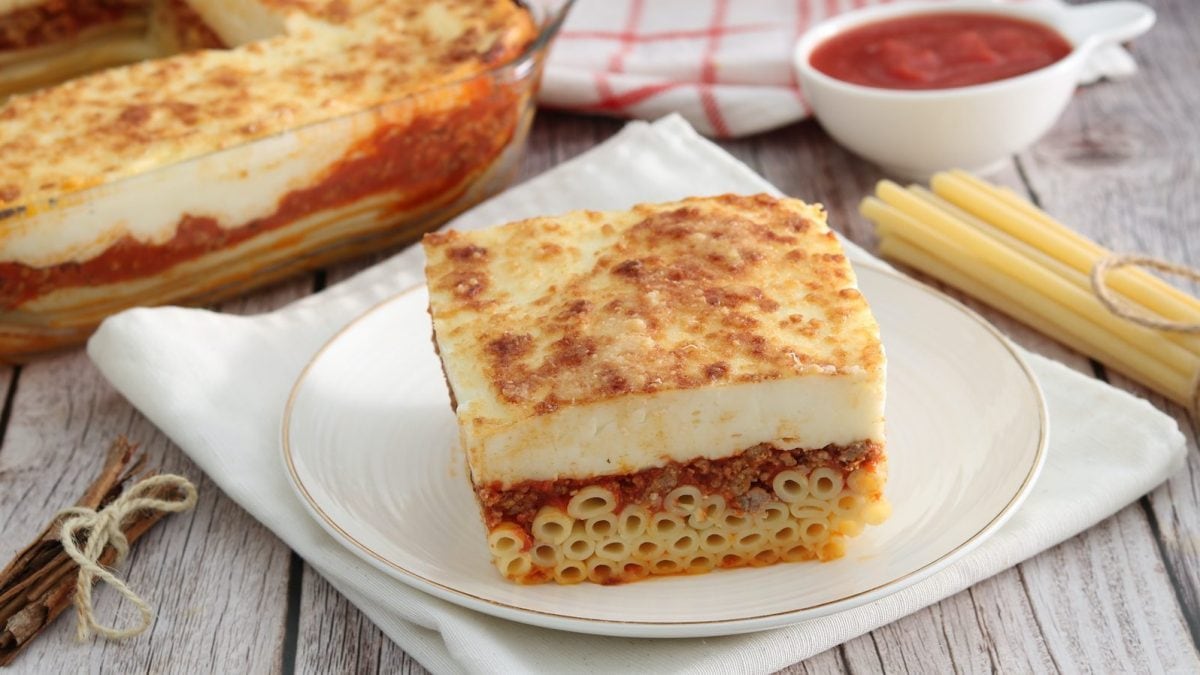
Pastitsio is a typical Greek pasta dish, consisting of a bottom layer of ziti, covered with a tasty ragù made from minced beef, tomato puree and cinnamon, topped with a creamy béchamel sauce and finally sprinkled with grated Parmesan cheese.
Baking creates a delicious main dish, perfect for Sunday lunch or a dinner with special guests, along with moussaka and other Greek specialties. It's a recipe for special occasions, similar to classic lasagna, though it differs in the pasta shape used and the characteristic layering of ingredients.
What is Greek Pastitsio? How Do You Pronounce It?
Pastitsio (pronounced "pahs-TEE-tsyo") is a beloved Greek dish that combines layers of pasta, a rich meat sauce, and creamy béchamel. Its origins date back to Greece, where it is often considered a comfort food, particularly served for special occasions or family gatherings. The dish itself is believed to have been influenced by the Italian pasticcio, a type of layered casserole, which was adapted by the Greeks using local ingredients like lamb, beef, and macaroni.
The exact origins of pastitsio in Greece are debated, but it has been a staple in Greek cuisine for centuries, influenced by both Mediterranean and Ottoman culinary traditions. The Greek version typically features a combination of pasta, minced meat (usually beef or lamb), and a flavorful tomato-based sauce, all topped with a smooth béchamel sauce.
Pastitsio made its way to the United States with Greek immigrants during the late 19th and early 20th centuries, along with other traditional Greek dishes like moussaka and souvlaki. As Greek communities settled in cities across America, pastitsio quickly became a favorite in Greek-American households and restaurants. It found its place alongside Italian-American pastas, providing a different but equally comforting option for pasta lovers. Over the years, it has become a beloved dish within American food culture, often appearing on menus in Greek restaurants or as a homemade favorite for family meals.
Pro Tips for The Best Greek Pastitsio
- For the best flavor, use a mix of beef and lamb for the meat sauce. Lamb adds a unique richness and depth to the flavor. If you prefer, you can use all beef, but the classic combination is key to that authentic taste.
- Allow the meat sauce to simmer for a longer time to let the flavors fully develop. The sauce should be thick, rich, and aromatic. Adding a pinch of cinnamon or a bay leaf during cooking can enhance the flavors and give it a distinct Greek touch.
- For a creamy and smooth béchamel sauce, be sure to cook the roux (butter and flour mixture) just enough to get rid of the raw flour taste, but don’t let it brown. When adding the milk, do so slowly while constantly stirring to avoid lumps.
- Cook the pasta al dente (slightly firm) to avoid it becoming too soft once baked. Ensure you spread the pasta evenly in the baking dish so it creates a solid base for the meat sauce and béchamel.
- After baking, let the pastitsio rest for at least 15-20 minutes before serving. This helps the layers set, making it easier to slice and serve, while also allowing the flavors to meld together beautifully.
- Make sure to add a generous layer of béchamel on top of the meat sauce and pasta. This should be thick enough to form a golden, crispy top when baked, adding texture and a beautiful finish to your pastitsio.
What is The Difference Between Lasagna, Moussaka and Pastitsio?
Lasagna is an Italian dish made with layers of wide pasta sheets, marinara sauce, ricotta or mozzarella cheese, and ground beef or pork. Moussaka, a Greek and Middle Eastern dish, uses layers of eggplant, ground meat (often lamb), and a rich béchamel sauce. Pastitsio, also Greek, features layers of pasta (usually macaroni), a spiced ground meat sauce (often beef or lamb), and a creamy béchamel topping, similar to lasagna but with a distinct pasta and spice profile.
What Kind of Pasta is Best for Pastitsio?
The best pasta for pastitsio is short tube pasta, typically penne or ziti. These types of pasta have a sturdy texture that can hold up well under the layers of meat sauce and béchamel. The hollow shape also allows the sauce to cling to the pasta, creating a flavorful bite. Some variations of pastitsio even use macaroni, but penne or ziti are the traditional and most commonly used choices.
What Does Pastitsio Taste Like?
The pasta is soft yet slightly firm, providing a satisfying base. The meat sauce, typically made from ground beef or lamb, is seasoned with aromatic spices like cinnamon and nutmeg, giving it a warm, slightly sweet undertone. The creamy béchamel sauce on top adds a velvety richness, balancing the spiced meat and pasta. The overall taste is savory, creamy, and slightly tangy, with layers of depth from the sauce and a hint of Mediterranean flavors.
Can I Make a Vegetarian Version of Pastitsio?
Yes, you can make a delicious vegetarian version of pastitsio! Instead of using ground meat, you can substitute with ingredients like lentils, chopped mushrooms, or plant-based ground meat to replicate the texture and heartiness of the traditional meat sauce. For added flavor, season the filling with Mediterranean spices like cinnamon, nutmeg, and oregano. You can also add sautéed vegetables like zucchini or eggplant for extra texture and depth. For the béchamel sauce, ensure it's made with butter, flour, and milk (or plant-based alternatives) to keep it creamy.
What Can I Serve With Pastitsio?
A refreshing Greek salad, with cucumbers, tomatoes, red onion, olives, and feta cheese, provides a cool, tangy contrast. Roasted vegetables, such as zucchini, eggplant, or bell peppers, complement the flavors of pastitsio and add a light, healthy side. Warm, crispy garlic bread or pita is perfect for soaking up the delicious sauces, while tzatziki, a cool yogurt and cucumber dip, adds a refreshing touch. Lightly sautéed spinach or steamed broccoli offers a nutritious, slightly bitter element to balance the richness of the dish.
Can I Make it Ahead of Time?
Yes, you can make pastitsio ahead of time. You can prepare it entirely, then cover and refrigerate it for up to 1-2 days before baking.
Does It Freeze Well?
Yes, pastitsio freezes very well. To freeze it, assemble the dish but do not bake it. Once assembled, allow it to cool completely, then wrap it tightly in plastic wrap and aluminum foil, or store it in an airtight container. It can be stored in the freezer for up to 3 months. When you're ready to bake, you can either thaw it overnight in the refrigerator or bake it straight from the freezer, just allowing for additional baking time to ensure it's heated through properly. Freezing helps preserve the dish’s flavors and makes for an easy meal later.
How to Store Any Leftovers
To store leftover pastitsio, allow it to cool completely before transferring it to an airtight container. You can refrigerate it for up to 3-4 days.
When reheating, you can warm it in the oven for the best texture, or microwave it if you're in a rush.
Ingredients
How to Make Authentic Greek Pastitsio
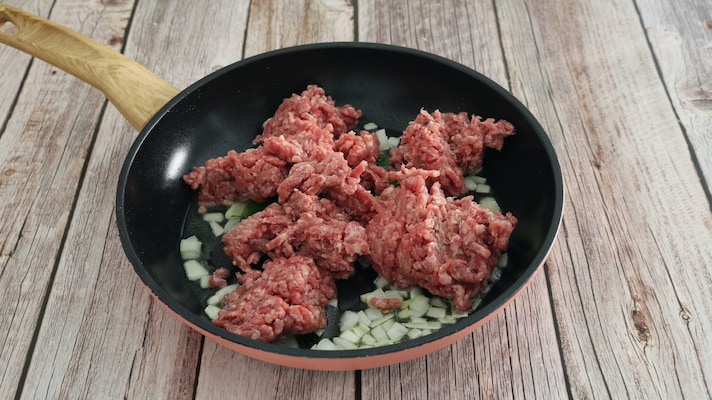
To prepare the pastitsio, start by heating a drizzle of oil in a pan, fry the chopped onion and bay leaves, then add the minced beef and brown it over low heat, breaking it up with a wooden spoon. If you prefer, you can also use a mixture of beef and lamb.
To prepare the pastitsio, start by heating a drizzle of oil in a pan, fry the chopped onion and bay leaves, then add the minced beef and brown it over low heat, breaking it up with a wooden spoon. If you prefer, you can also use a mixture of beef and lamb.
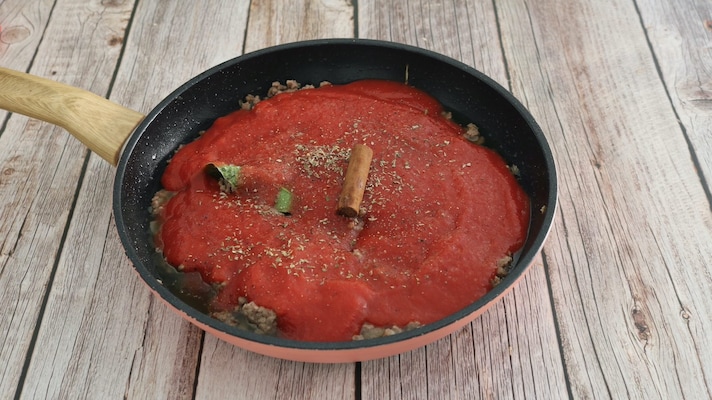
Once the meat has changed color, pour in the tomato puree and season with cinnamon stick, oregano, salt and pepper. Mix well, then continue cooking the ragù for about 1 hour.
Once the meat has changed color, pour in the tomato puree and season with cinnamon stick, oregano, salt and pepper. Mix well, then continue cooking the ragù for about 1 hour.
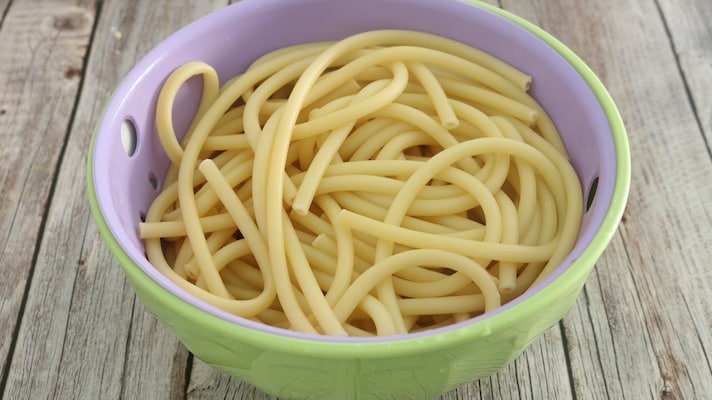
While the ragù is cooking, boil the ziti in plenty of lightly salted water, then drain them when still al dente and collect them in a bowl, then drizzle them with a little oil and mix gently to avoid breaking them. Ziti is the best pasta shape for this recipe, but you can also use rigatoni or tortiglioni.
While the ragù is cooking, boil the ziti in plenty of lightly salted water, then drain them when still al dente and collect them in a bowl, then drizzle them with a little oil and mix gently to avoid breaking them. Ziti is the best pasta shape for this recipe, but you can also use rigatoni or tortiglioni.
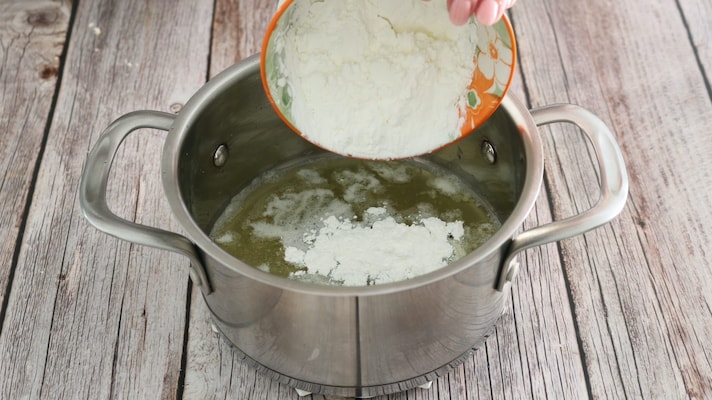
Make the béchamel sauce: melt the butter in a saucepan, then add the corn starch and mix well with a whisk, so as not to form lumps.
Make the béchamel sauce: melt the butter in a saucepan, then add the corn starch and mix well with a whisk, so as not to form lumps.
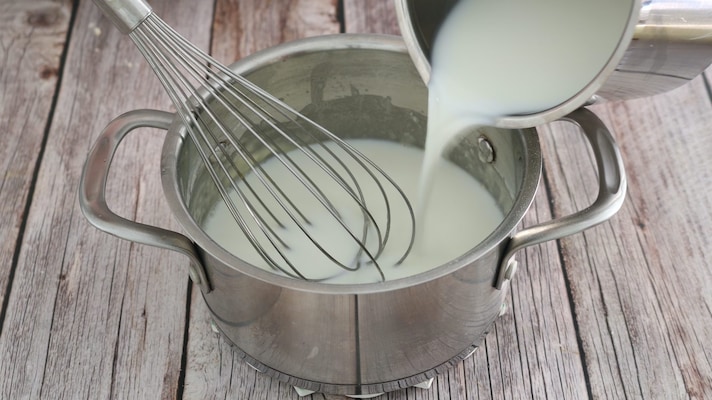
Once you have obtained a smooth and golden roux, pour in the very hot milk and continue mixing to create a thick, lump-free béchamel sauce.
Once you have obtained a smooth and golden roux, pour in the very hot milk and continue mixing to create a thick, lump-free béchamel sauce.
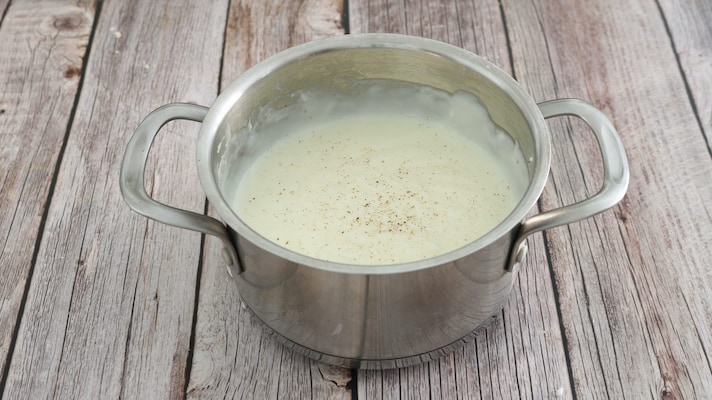
Once ready, remove the béchamel from the heat and season it with a pinch of salt and a pinch of nutmeg, then set it aside and let it cool.
Once ready, remove the béchamel from the heat and season it with a pinch of salt and a pinch of nutmeg, then set it aside and let it cool.
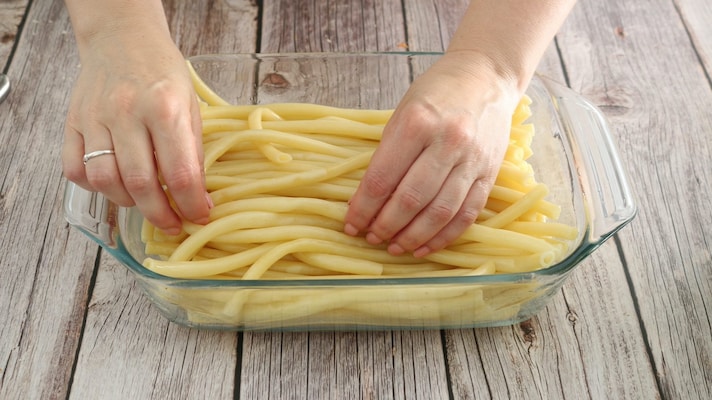
Assemble the pastitsio: arrange the ziti on the bottom of a baking dish lightly greased with oil, arranging them all in the same direction.
Assemble the pastitsio: arrange the ziti on the bottom of a baking dish lightly greased with oil, arranging them all in the same direction.
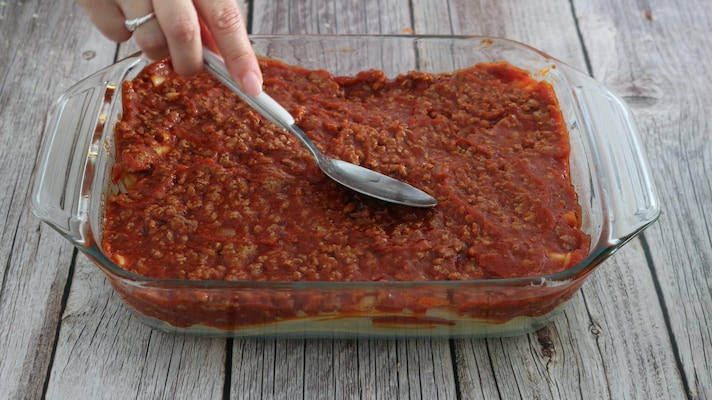
Add a layer of ragù, spreading it well with the back of a spoon so that it is even.
Add a layer of ragù, spreading it well with the back of a spoon so that it is even.
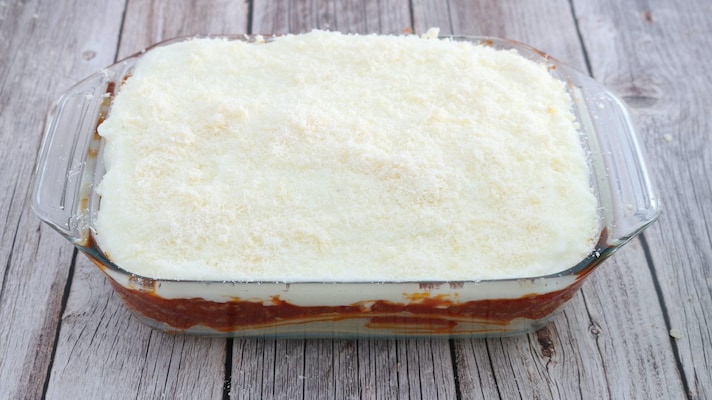
Finish with a layer of béchamel sauce and then sprinkle the surface with plenty of grated parmesan cheese. If you prefer, you can use sweet pecorino or top with crumbled feta. Finally, bake the pastitsio in a preheated oven at 200°C/390°F for 20 minutes, removing it when it's golden brown and au gratin on top. If necessary, set the grill to 5 more minutes.
Finish with a layer of béchamel sauce and then sprinkle the surface with plenty of grated parmesan cheese. If you prefer, you can use sweet pecorino or top with crumbled feta. Finally, bake the pastitsio in a preheated oven at 200°C/390°F for 20 minutes, removing it when it's golden brown and au gratin on top. If necessary, set the grill to 5 more minutes.
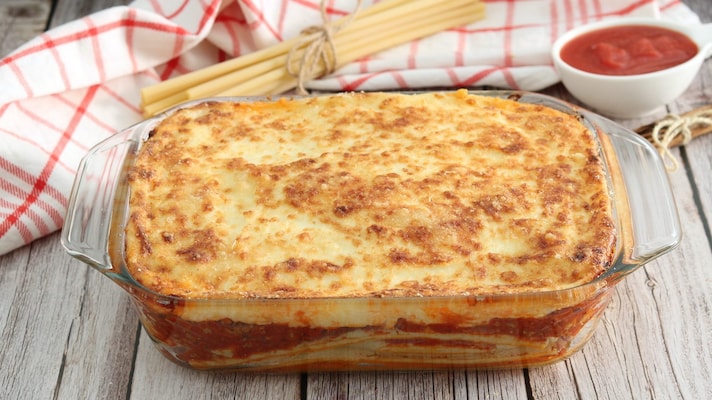
The pastitsio is ready: let it settle for 10-15 minutes before serving. Enjoy!
The pastitsio is ready: let it settle for 10-15 minutes before serving. Enjoy!
;Resize,width=767;)
